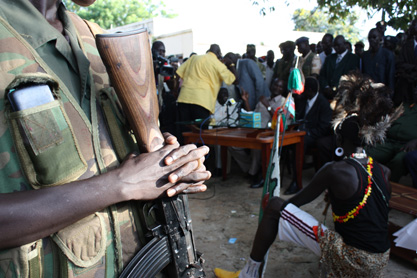
Introduction and executive summary
South Sudan’s remarkably peaceful referendum momentarily assuaged concerns about violence in the region, but outbreaks of intense fighting in Jonglei on February 9 and 10 that left hundreds dead, and in the flashpoint town of Malakal on February 4, provide stark reminders of the tensions that remain. This report, based on extensive interviews conducted in Upper Nile state in January and February 2011, provides an overview of the state of play among South Sudan’s militias, which continue to be a critical challenge to securing a peaceful separation between North and South Sudan, and to the formation of a stable new state.
One reason why the referendum took place relatively peacefully in flashpoint regions was the concerted effort on the part of the South Sudanese government to reconcile with breakaway militia leaders beforehand. The olive branch that was offered appeared to be accepted by a number of key militia leaders. But just weeks after the announcement of the South’s overwhelming preference for secession, intense fighting broke out once more, amid allegations of support from Khartoum for the dissidents.
Significant hurdles remain before peace in South Sudan can be assured for the long-term. Any future peace agreements between the South Sudanese government and dissident elements will face serious challenges in their implementation and remain vulnerable to security threats from spoilers—both from Khartoum and from splintering within the militias themselves. Operationally, integrating militia members into the SPLA is complex and will come at a long-term cost for a government that must eventually reduce the size of its military and disarm its civilian population.

Above: A reconciliation ceremony between Gabriel Tanginy and Unity State Governor Taban Deng in Bentiu, Unity State in October 2010 (Photo: Matt Brown/Enough).
Although there is a deep and explicit desire among southerners to reconcile with armed nonstate actors, the situation is extremely fragile and high levels of distrust prevail. Ultimately, confidence-building and addressing the root causes of conflict in the South takes time and action, and cannot be achieved simply through paper contracts. U.N. representative David Gressly has warily remarked, “The signature of the peace agreement is only the first step. Implementing it is the hard part."
Some of the key elements in a comprehensive strategy for neutralizing militia groups in South Sudan are the following:
- An unpalatable but necessary strategy of co-option of militia leaders through negotiations that offer integration into the GOSS army as well as other perquisites.
- A more fulsome disarmament, demobilization, and reintegration program for rank and file militia members who wish to leave military service, and integration into the southern Sudanese army for those that want to remain.
- A demonstrated commitment by the ruling Sudan People’s Liberation Movement toward inclusive governance, in the form of a democratic constitutional review process and independent political party and civil society development.
- A concerted strategy by the southern army, as well as local security forces and police, for protecting civilians in future attacks.
- A targeted military strategy for recalcitrant militia elements that reject options for integration and pose a threat to civilians, undertaken with international monitoring and in line with human rights standards.

